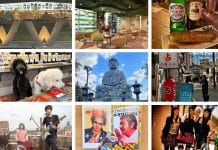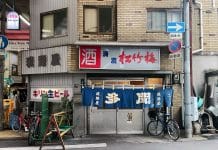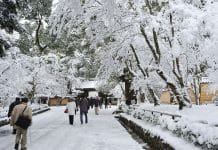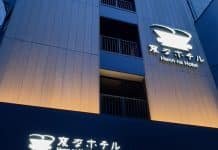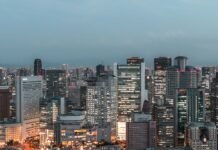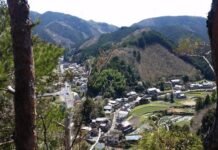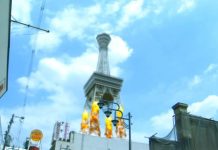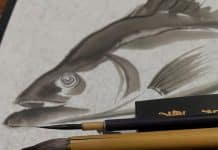
Table of Contents
Introduction
Kuromon Ichiba Market: The center of “Osaka’s kitchen.” Officially known as the ‘Kuromon Market Shopping District Promotion Association’, it is Osaka’s smaller counterpart to Tokyo’s Tsukiji (minus the tuna auction). Foodies heading to Osaka, stamp this destination into your top three! Spanning 580 meters with over 150 shops, stalls, and restaurants, it has been considered Osaka’s “stomach” throughout its elaborate 200-year history, offering high-quality seafood, meats, greens, rice, fresh fruit, juice, coffee, desserts, and much more. Today, it is touted by locals and tourists alike as a “must-visit”, “do-not-miss attraction” – a top-notch tourist destination!
According to legend, around 1822, fish merchants began selling their wares on the sweeping grounds of Enmyou-ji temple. A stunning, black-lacquered ‘mountain gate’ stood at her northwest entrance. As the market’s popularity grew, so did its size, with over 150,000 visitors flocking to its streets daily by the Taisho era. At its peak, it boasted 270 shops and 540 merchants, with the iconic black gate becoming a symbol of the market. Thus, the name “Kuromon,” meaning “black gate,” and “Ichiba,” meaning “market bazaar.”
Although both temple and gate were lost in the Great Namba-Sennichimae Fire of 1912, the market was rebuilt once more. While the black gate itself is now nothing more than memory, its legacy lives on in its reputation: “Kuromon Ichiba is a ‘treasure trove’ of things to find, a place where the sights, feel, tastes, and local friendliness take you back in time to a thriving Osaka open-air bazaar – once and still known as the one market to find “anything and everything”.
Nipponbashi


December 28, 2024, 07:15. Just north of Sennichimae.
A biting wind whips down alleyways of old, corrugated metal-topped buildings. Through tangled wires above, spitting snowflakes fall. One frozen hand cups the camera lens strapped around my neck, the other hand deep in my jeans pocket. I crave anything hot. My first destination: Fuel. Black fuel found only at IBUKI COFFEE, located east of the northern segment of Kuromon Ichiba’s main street.
As the wind howls, my pace quickens. I ponder Kuromon and her monicker, “anything and everything to be found”. On this frigid morning, I am eager to uncover whether or not such treasures still exist here. A glance westward, I see people are crammed already within the main alleyway of Kuromon’s North arcade entrance. It’s not even seven thirty! Coffee first.
IBUKI Coffee Shoppe 伊吹珈琲店
Address: 2-12-31 Nipponbashi, Chuo Ward, Osaka. Tel: 06-6632-0141 Hours: 7:00-18:00.
The wood-paneled doors of IBUKI loom before me. Redemption awaits! A kindly woman—customer or employee, I’m uncertain—holds the door for me, poses, and flashes a smile as I depress my shutter. Snap. I follow her in.



Heat and fragrance hit me like a freight train. IBUKI exudes a 1930s French charm: plush leather seats, a wood-paneled interior adorned with mirrors and chandeliers. The cafe boasts an impressive on-site coffee roaster with a great iron front, ‘F. Royal’ forged onto the hood.

A kind waitress takes my order. In no time at all, a “Toasted Bread and Egg with Coffee” set arrives at my table. I savor the cafe’s Showa-era blend, a mix of coffee beans and soybeans, best enjoyed straight and hot. As I begin to thaw out, I review my notes.
Flashback: A Call to Kuromon

“Hi Wes. A.H. from osaka.com here! What do you know about Kuromon Ichiba Market in Osaka? And… would you consider writing it?”
Normally, I’d dive in headfirst. This time I hesitated.
In 25 years I had been to Kuromon Ichiba less than 25 times, usually in my mid-afternoon commute: tired vendors, lackluster offerings, melting ice in the twilight of the oncoming evening.

What did I know about it? And what could we possibly say that hasn’t been said or written before? Most of my private perceptions were formed as much as 20 years before.
Though widely recognized that Kuromon Ichiba, in resilience and tradition, has hung on through challenging times, let’s be frank. It is equally well known amongst expats and locals alike that the market has never been regarded as, shall we say, “affordable”. In times past many expat friends dismissed the market as overrated and excessively overpriced: “The only time we are found walking through Kuromon Market is on our way to Burger King!”
Hearsay aside, my factual notes reveal the turbulence behind the reputation earned over the last two decades.
Bird’s Eye View
From the turn of the century, Kuromon Ichiba had literally been panting in recession. Another 13 long years, and many a long-standing shop and shopkeeper fell by the wayside. Other shops were barely able to hang on.
Two decades of changes in Kuromon Market:
1990s: Prices remained high after the 1989 bubble burst, causing customers to flag.
Early 2000s: Many arcades in Osaka closed, marking the end of an era for cultural hubs.
2008: The Lehman Shock led to a decline in sales and the loss of longstanding merchants and shops.
2011: Government policy changes, low-cost carriers, and visa relaxations helped revitalize Kuromon, boosting international tourism.
2014-2020: Inbound tourism to Osaka doubled, but growth ended abruptly due to the global pandemic
2021 (Post-Pandemic): Tourism to Osaka quadrupled. The surge in visitors led to the displacement of local customers and rising prices.
2023-2024: Accusations of price gouging spread online, with the market being labeled “BOTAKURI ICHIBA” or “Rip-Off Street” due to its alleged over-reliance on tourist money.
Suddenly, seemingly out of nowhere, a switch was flipped! 2014 saw inbound tourists flocking in droves. Post Coronavirus years saw a second surge that quadrupled that number of tourists. Both surges primarily benefitted shopkeepers yet alienated local chefs, hotels, businesses, and its long-time customer base, as prices soared far beyond ‘normal’.


The subsequent few years would see the market struggle to balance commercial viability with cultural heritage, often teetering between authenticity and tourist appeal.

By the time of this request, July 2024, there had been (between 2023-24) new terms viciously slung at the market Association. Radio and internet hype were rife with terms like “over-tourism” and “pandering to tourists’ money. Its newest term:“BOTAKURI!! “(Rip-off Street) in particular, left me unsure if I wanted to engage with these narratives.
Something for Everyone
By September 2024 (none too enthusiastic to simply write an undo marketing pitch) I was still not convinced we could write anything that had not already been written until I came upon this caveat that changed my mind. It challenged hearsay and gave me an angle worth writing. It came from the Kuromon Association addressing the unfair backlash:
“Yes, initially our prices rose universally with the influx of tourist spending. As of August 2024 however, we have revised our pricing to a ‘reasonable pricing system.’ While some shops, largely those not within the Union Association —many foreign-owned—continue to inflate prices without revision, our unionized stores have made concerted efforts towards establishing a FAIR PRICING MODEL benefiting locals and tourists alike! THERE IS SOMETHING FOR EVERYONE HERE NOW as we continue to evolve, always in committed service to the hbdcommunity.” (Credit: Kuromon Ichiba official website)

That last line—“Something for everyone!” As well as the old motto, “Anything and everything to be found here!”—inspired me. Maybe, just maybe, I had unearthed an angle.
Though I could have easily taken a second cup of that magnificent coffee, I packed my notes, thanked and paid the waitress, snapped a few photos of IBUKI’s cozy interior, then pushed myself back out into the cold.
Go Early and Hungry, Leave Late and Full
I make my way towards the entrance to the market. I realize, I am doing a thing I’d never bothered with before: VISIT THE MARKET FIRST THING IN THE MORNING.
A friendly vendor recently told me, “If you’ve been here in Osaka for any time and have never witnessed the market off to an early start, you haven’t truly seen the market.”

I was about to see just how correct he was and how unaware I’ve been of the market’s true morning energy.
The arcade has seven main parcels, each with seafood-themed avenues crisscrossing side streets. To my astonishment as I round a corner onto Shrimp Street, I find myself chest deep in moving bodies—rush hour on a runaway train—a sea of faces flooding toward me!
“There is a special rule many don’t realize,” the vendor had told me. “Come here as early as possible- before the rush. Be one of the first! Come hungry! Leave later when you are full!”
(Best times on normal days are to come before 9AM. On events like the years end, best to arrive before 8 AM.)
Kuromon Ichiba: First Bell

I had thought I was early, simply joining a few early birds. It is 7:58 AM and the arcade is absolutely filled; how on earth? Somehow I am late. Everybody is already here!

Above the throng rises a great many voices:
“IRRRRASHAIIIIIII! Irashaiiii, Irashaiiiiii!” (“WELCOME!”) twenty or more vendor pitches clamber in unison while a golden hammer resounds on a great brass gong: ‘Dang-danga, Dang-danga, Dang-danga, Daaaaannnnng!’
0800. The market is officially open.
Entranced, I allowed myself to be swept into the swirling waters. Eager customers are queuing up both left and right. Jacket and scarf-clad bodies bustle around me, seeming to pick me up off of my feet. A single current, we bob down the corridor, bubbles on the surface of a rain-swept stream.

Mountains of food, banners, prices, signs, rise up on each side like waves of a sea parted. Lights, colors, movement. Everything is happening at once here: a cacophony of sound, tantalizing scents, an absolute sensory delight! Like moths to flame, various faces surge forward, eager to get in front of the source of whatever has drawn them here.

Left and right, the festive spirit is enveloped in warmth and color from top to bottom spanning the length of the arcade. Lights, lamps, lanterns, brightly lit tarpaulin roof covers in different hues of warm color are scattered down the main street and side alleyway.

Smiling, inviting vendors call to the crowd, leaning across counters, they make their pitch.

All souls warming within her covered corridors flow like molasses through her streets. All retain faces of intense scrutiny, anticipation! Billfolds soften, purses open, the clink of coins and paper money change hands.


Today will surely see me hand over a thousand yen bill here… two… or three there in likely rapid succession. The paper bills, I know, will emerge from my wallet as though greased, reeled in on a hook and fishing line. And why not? I already feel myself, a fish out of water, caught up in the net.


After all, the vendors are fishers at heart—in trade and pitch! Their friendly faces openly promise to tantalize with both sights and smells, making it more than easy enough for me, for anyone, to part with their papery friends.

“Oiiiiishiiii yo! UNAGIIIIIII! Unaaaaaagggiiii! AIIIICHI-KEN KARA UNAGIII HA KOCHIRA-E! Yaitei agerrrruuuuu yoooooooo!” (DELISHIOUS! Aiichi-ken conger eels grilled here! We grill them for you!)
“Tuna here! The best in the nation!” A gigantic tuna head sits like a trophy upon a counter.
Year-end Sale

Flower shop staff prim and plump roses, tiger lilies, carnations. Fruit shop workers line the benches with the day’s freshest fruit encased in white wrappers and set upon colorful flats and blue baskets. A high school girl’s voice rises above the rest. “Start your day with our freshest juice!

Apron-clad men and women in knee-high, white rubber boots are bustling here and there with hoses, boxes, trays of food, boxes stacked high with oysters and shells of varying size, trays of eel and strings of fish.

Gigantic crab legs, urchins, frozen scallops, jumbo oyster shells yet to be cooked, yellowfin skipjack tuna, hand hooks through gills, stainless steel troughs brimming with ice.
Though I’ve lived in seaside towns, I have never seen so much seafood and more stacked up in one place! Walls and walls of food
Up ahead, a great banner hangs high and centered, proclaiming this year’s special benchmark:
“Kuromon’s 200th Anniversary.”


A giant red lantern KUROMON ICHIBA in black across the lantern’s globe can be seen hanging high above after a great banner proclaiming its 200 long procession to the year 2024, while yet another banner reads: “YEAR END SALE!”. Thus the molasses!
Let’s Explore
As I venture further, I find myself immersed in the sights, sounds, and aromas of this 2oo-year-old institution. From IBUKI COFFEE’s nostalgic ambiance to the South Arcade’s bustling energy, each stop reveals a fragment of Kuromon’s identity.

Booth after booth offer amazing foods, stacked up like I had never seen before. Snap. Snap. My shutter is on fire!
The freshest and coldest oysters on the half shell lay on ice so frigid, steam rises like a fog bank. Everything, everywhere.

Golden fried seafood on one side of the street, beef on the other. a little farther on, cuts of fatty O’toro and chu-toro tuna are sliced only one way: a single long-bladed cut, thick, rich, and absolutely delectable!
Full sets of sushi combinations such as tuna, salmon, scallops—all thickly sliced, arranged, and drenched over with ladles of bright, red-orange Ikura, salmon eggs. Interspersed between seafood shops comes Wagyu beef, laced and ribboned with the fatty taste they’re known for!

Rated A5, grilled to perfection before your eyes, they are said to be worth every penny. The prices posted make me wonder just how good A5 beef must be. It’s not the easiest thing to say, “Sure, ONE skewer for three thousand yen please!” Ahem, not meaning to appear cheap. The first skewer sure! How about the second one- and the third when you just can’t stop at one?

I make my way along, going with the flow. Crab shells full of boiling kanimiso (crab brain) and cheese gratin bubble, while jumbo scallops, thick and juicy, hiss over ceramic heaters.

Vendors using gas torches burnish the red shells of crab and lobsters with blue flame, inviting both you and I to try the taste of a lifetime.

One thing I notice right away is many things are being sold from a one coin (¥500) to just hovering above ¥1000-2000. Asking one of the vendors whether these items one can buy and “eat as they walk” are priced low for the year end sale only, he replied,
“No, things like these are generally the same on any day you come. We have strived to serve our items in single units, reflecting prices that are easier to pay to sample what we have here.”


I recall the Kuromon Association website listed this as one of their recent implements within the last decade; lower prices attract. Maintain quality but make smaller offerings to offset lower prices, making it affordable for all to indulge!

Excitement is palpable here. The sea of faces swing left and right, surging through the main street, spilling out onto the cross streets. The crowd seems possessed of a spirit, one of reckless abandon, irrepressible hunger, an eagerness to drop any and all sorts of cash for treats.

Average prices at many of the stalls are the same, many with one coin (¥500) deals on skewered treats of all sorts. Beef and lobster command a bit more respect at ¥1500~1800. At any shop the “Eat now!” offerings seem to range between ¥400~¥4800 depending on what one fancies. Many shops have “EAT IN” spaces withing the establishment to enjoy one’s chosen treats.

I am thrilled to see people content and excited. Indeed there seems to something for everyone at the many, various stalls. My stomach growls, forgetting the coffee and sandwiches just an hour or so before. (Breakfast? WHAT BREAKFAST?!) My brain has hardwired my tongue, hijacked my stomach in anticipation! Only, I will need to save my stomach; there’s still so much to see.
Fukahiro Honten: Fresh Fish Wholesaler 深廣本店
Address: 大阪市中央区日本橋 1-22-23. Tel: 06-6633-3000. Hours: 9:00-16:00. Website Holiday 1/1~2

The smiling, pretty face of a girl floats above the crowd. I move closer. She’s standing on stacked crates. Canvas pants tucked into rubber boots, a waterproof jacket, pink-painted fingernails holding a sign: TORA FUGU (tiger pufferfish) ¥8,000.

Her voice travels out over the sea of faces: “Special year-end prices here at Fukahiro! Welcome!”
The tarpaulin ceiling behind her reads “Fukahiro—since 1905”—one of the older shops in the association!
A chain wholesaler, it sells high-quality seafood daily to hotels, restaurants, izakaya (pubs), and sushi chains. The Kuromon location has a cook on the spot—eat-in shop.


Boxed up, on ice, seemingly reasonable prices are had on fresh abalone, sea cucumber, octopus, tuna, yellowfin, Ise lobster, cod roe, various shrimp, king crab and snow crab, and of course, blowfish. They also specialize in various donburi, one being “ERANDE-DON” (choose your own rice bowl) as their recommended specialty.
The girl with the sign glances down and pauses to smile for my lens. Two-fingered ‘Peace!’ Snap. Snap.

“How about Fugu?” she asks me in English. I smile but kindly decline.
“Is it warm up there?” I ask. Laughing, she nods vigorously!
I am pushed along by the crowd. The smiling girl waves as I float away.
Otafukudo Confectionary Shop おた福堂 菓子店
Address: 大阪市中央区日本橋 2-2-22. Tel: N/A. Hours: 0900-1700. Holiday: None

A colorful booth adorned in purple and pink catches my eye as I learn to navigate the deep waters; I make my way to the countertop. Tall, long-cut purple yam chips are all the rage here. Sold in small and large sizes, they are stacked well over the brim!


Deep-fried orange with purple rind, I opt for the small cup. They are sweet, savory, salty, and warm!
Otafukudo’s main feature is strawberry daifuku (mochi parcels) with plump, ripe strawberries on top. One by one they are lined up in the glass case like soldiers on parade.
Words in hot pink hang above the glass fruit case: STRAW BERRY.
Skewered strawberries stand at a position of attention upon the top glass. Children stand on tip-toe pointing at them, eyes wide, ogling as well the strawberry mochi parcels at nose level. As I pass them, I hear their mother say, “You may each choose just one!” I pause here thinking of all mothers everywhere reflecting that my own mother often said the same.
Unagi Takagi Suisan うなぎ高木水産
Address: 大阪市中央区日本橋2丁目3−18. Tel: 06-6634-8018 Hours: 10:00-17:00. Holiday: 1/1~ 1/3

“Aiichi-ken fresh conger eel sold here! Plump and juicy! Don’t miss your chance for the best tasting eel anywhere!” My attention is drawn by a dealer in conger eel. The detour takes me onto Crab Street to an orange-colored booth with its complementary indigo blue noren hung above the entrance. Its twisting kana characters, う·な·ぎ read unagi, eel and form a conger eel in the first character. I find its depiction mesmerizing and wish they had one for sale.
Fresh eel however—not noren— is sold here.


P.C: fujimotogj.hatenadiary.jp

Renowned since 1930, their savory aroma has attracted decades of hungry consumers. Full slabs to take home, half and quarter slabs grilled in the rear of the shop, mini racks skewered in triplicate, three to four skewers through each square body to keep the eel from twisting in the heat atop the grill.
Nami no Koromo Tempura Shop 波の衣
Address: 大阪市中央区日本橋 2-12-17 Tel: None Hours: 0900-1730. Holiday: 1/1-1/5

“Have it your way!!” cry the young female vendors at Nami no Koromo. “Eat here… or take it and walk!” TABE-ARUKI!!” (Eat as you stroll!)

The friendly faces of the staff beam out from behind a veritable mound of golden fried treats. Signs abound urging customers to follow the process as follows: order first, have the order fried, then eat in or take it on their way.
This encouragement comes from a fairly new concept to the market in recent years. Tabe-aruki is one of many initiatives to create sustainability in uncertain times. The idea is to meet customers’ desires mid-way, especially foreigners. “Why not create a street-fair environment?” the association proposed.

Hot oil bubbles in great copper urns. Various seafoods are fried to golden perfection here: super-sized tiger shrimp, octopus legs, squid, fish cake, scallops, and more. One coin buys a luxurious fried-on-the-spot jumbo ebi, shrimp. I happily take one on my way.

There is certainly something for everyone at Nami no Koromo. It is impossible to not find something of one’s instant liking! Prices have seemed to be lowered for everyday strollers to sample some of the best fried food in the market!
Yamacho Sengyou・Fresh Fish Wholesaler 山長商店
Address: 〒542-0073 大阪府大阪市中央区日本橋2丁目3. Tel: 06-6563-9444 Hours: 0900-1800. Holiday: None fixed
Jumping back into the mainstream, the crowd spills onto Pufferfish Street. A large, round grilling contraption stands in front of Yamacho wholesalers.

They are grilling skewers of seafood and wagyu sirloin within the outer ring of the unit packed with what looks like sand, but is more likely nuka (ground rice husks that when wet form a sort of mud).
A tower of hot coals rises from the middle of the unit, metal braziers stacked like a burned-out building, flaming embers inside. Conger eel, cod, squid, octopi legs, scallops, crab, imitation crab, lobster, and more—all are skewered and set standing in the ‘sand.’ Formed into a semi-circle of seeming totem poles, each bask in the scalding heat of the brazier. Grilled shells and toasted skins fill the air with the scent of salt, charcoal, and smoke.

Yamacho was founded in Wakayama during the Edo period (1603-1868). Here, they are less bent on tradition and more geared towards ‘evolving rich tastes’ to make customers feel ‘at ease with the times’. Their menu is quite extensive, all at very reasonable prices!
Colorfully illustrated placards boast a plethora of combinations paired with exotic ingredients. From seafood bowls and tempura to top-of-the-line fresh nigiri sushi or maki sushi rolls- the choice is yours at Yamacho!


Seasonal Japanese foods are the main sell, based always around the freshest fish—often grilled. According to their official website, Yamacho strives to be the one vintage shop to define what JAPANESE food is today.
I ask if it is okay to take pictures, (a thing expressly forbidden before the age of smart phones and instant NET access). “Snap away!”
A few snaps of the shutter later, a hot skewer of freshly grilled and salted squid and I make our acquaintance. I munch happily toward the next venue.
Yasojima・ Crab Wholesalers 八十島
Address: 〒542-0073 大阪府大阪市中央区日本橋2丁目3−2. Tel: 06-6775-8040 Hours: 030-1430. Holiday: 1/1

HANDS OFF!! Take note—and the notes are posted— “Don’t touch the crab” at Yasojima unless you are prepared to buy!
Yasojima’s signature product, some of the largest Tarabagani (king crab) in the entire market, are sold here. Many crabs are shipped to hotels and businesses directly from their production area.




Others are packaged to take home, thaw, and eat raw. Be prepared to break the bank; however, these aren’t necessarily for everyone!
If money is no issue, why not take home a whole crab? Boxed, an entirety can go from ¥45000~! Or why not delve into their gift boxes of uni (sea urchin) delicacies and more? Ornately packaged, they are the perfect gift for that special someone in your life—and they best be special—really special!

Their freezers are stacked with a luxurious lineup of Snow crab, King crab, Imperial crab, Cod crab, shrimp, and eels to grill, packaged crab for Nabe (hot pot).
Remember that ‘something for everyone!’ quote? One online Japanese consumer writes:
“Let’s face it, (at the prices thick-sized crab goes for today) in my lifetime, I will likely never again get my hands around even a jumbo crab leg. However, an alternative exists! This shop, Yasojima (and a good many others) also grill imitation crab called ‘kanikama’ that resemble the thick legs of a red king crab. I am thankful to the person who came up with this idea!! Making the taste of crab familiar through kanikama though it is not real crab, we who cannot afford luxury, can enjoy eating these instead —while dreaming of eating the real thing— one day!” (we-love-osaka.jp/kuromon/)
Classic! I too move on while both my mouth and my eyes weep!
Ishibashi Shokuhin・Takeaway Bento 石橋食品
Address: 〒542-0073 大阪府大阪市中央区日本橋2丁目2−20. Tel: 06-6632-0433 Hours: 0900-1800. Holiday: Sun./ public holidays.
Across the way stands a favorite old relics of the market: the “Choose your own bento” space Ishibashi with its age-old green tarpaulin sign. Ishibashi is reminiscent of the old mom-and-pop shops that once dotted the old streets of Okinawa City (Koza) wherein once I resided long ago.
Family-owned and operated since 1974, they are known for a monicker that has stuck with them and is found on Kuromon’s official website:

料理に対する愛情とさじ加減が決め手のおふくろの味だ!
(“Ryourini kansuru aijotosaji kagen ga kimete no ofukuro no Aji da! -“When it comes to cooking, it’s the memory of my childhood, the memory of the tongue, based on a taste that is the love and time a mother puts into her food!”)
Light bulbs from above illuminate two smiling working staff. Their hands move swiftly, laying out trays of various mixed vegetables, salads, and fried foods upon the main line. Giant wafts of steam from wooden buckets spiral upward. A third shopkeeper pours hot dashi into a large steel trough.
The shining eyes of a woman peer through the steam cyclone as she hands trays of parboiled vegetables to patrons for coins. She nods and motions for me to try a tray!

When I come to Ishibashi, THIS is what I come for: Oden (a type of nabemono one-pot dish consisting of several ingredients such as boiled eggs, beef tendon, potato, Japanese horseradish, konjac, fish cake, burdock, lotus root, and more in a light soy-flavored dashi broth) ¥130~, you choose, and they serve.
Pure soul food! The sustenance fills my body, the steam burns the cold from my face. Ishibashi has perhaps the best tasting Oden in all of Kuromon Ichiba. Apparently, I am not the only one who thinks so.
According to the Kuromon Association, “In recent years not only Japanese people, but overseas tourists have been uploading #Ishibashi Oden to SMS one after another.”


Fellow American, foodie and travel writer, Mark Weins’ article on Kuromon can be found (here: https://migrationology.com/kuromon-ichiba-market-osaka/ with an extensive portion dedicated to this family-owned restaurant and their “exquisite” Oden: “I only saw one main and prominent stall selling oden when I was walking through Kuromon Ichiba Market, but it would be almost impossible to walk past without noticing it.“~Mark Weins
Take away trays of various bento foods are likely the cheapest prices in the market!
Iseya Shoten・Traditional picklers 伊勢屋商店
Address: 〒542-0073 大阪府大阪市中央区日本橋1丁目22−26. Tel:06-6641-6206 Hours: 0830-1730. Holiday: 1/1‐1/4

“Come here – taste tradition” is the monicker of this lovely tsukemono (pickled vegetables) specialty shop. Founded in Meiji 30 (1897) Iseya is one of the oldest shops in the arcade today.
“Welcome! Have you ever seen this before?” The lovely couple who run this shop share with me a few samples of their Tezen (newly -found-gold) pickle.
Various vegetables such as cucumber, eggplant, and radish, they explain, are immersed in a heavenly-tasting miso pate. Rishiri kelp paste is then added. The batch is then fermented for three months to a year depending on the vegetable.

“The results are quite satisfying are they not?” I nod happily. I’ve made two new friends.
I like them and their shop and tell them so. They treat me to deeper travels within their shop. A fan of fermentation, a fervent conversation surrounding the various fermented products in their shop ensues.

“In the case of the cucumber, the salts draw out any water left after pressing the vegetable under stone weights. The miso ferment causes amino and lactic acids to make the cucumber flexible yet still hard and chewy with the flesh darkened on the inside with a rich umami created by the miso.”

I leave the shop wiser with certain tricks I’d never heard before. Clutched within my grasp is a bag of miso cucumber with nuka (soy bean and rice husks) fermented Chinese cabbage.
Nishikawa Sengyou・ Pufferfish Wholesalers 西川銭魚店
Address: 〒542-0073 大阪府大阪市中央区日本橋2丁目3−4. Tel: 06-6631-1514 Hours: 1030-1800 Holiday: 1/1

Tanks and blue buckets at Nishikawa wholesalers perhaps attract more curious onlookers than buyers. Children and grownups alike stand agape in awe. Giant pufferfish swim in circles. I bend over a blue bucket, camera in hand. The clear water gives me a good look at the color and distinctive marks of the tiger pufferfish. Snap!

Nishikawa is a major distributor of fresh pufferfish from Nagasaki. For 69 years they have prepared and filled orders nationwide. Free shipping, set discounts, and bulk discounts are offered!
Signs welcome customers: “Sets can be purchased for take-home preparation or prepared for you onsite. Free sea urchins and oysters are also showcased on ice.
One of the Association’s initiatives back in 2014 to now was: more transparency. I see an example of this as I eye the boxed pufferfish-on-ice that has been prepared for take away; a warning that prices shown will increase if one so chooses to have it cooked inside the restaurant.


Well played Kuromon Shopping Association! Long ago, the eating-in option was well known as an expensive one, as consumers only knew the price shown on the fish!
You are Mistaken
Before I can move on, one of the Nishikawa staff in a large apron and white rubber boots approaches and asks me in English, what I would call this fish (in English) if I had to tell someone else what it was.
“Blowfish!” I answered.
“Wrong!” He exclaimed with friendly smirk and shining eyes. I could see the question was rigged from the onset. I braced myself for a lesson.

“Blowfish are quite round when they puff up, and they are characterized by possessing spines over the entirety of their bodies. Pufferfish, on the other hand, are longer and bigger in shape with only a few spines in a few places, thus easily removed. We sell only Nagasaki pufferfish, a popular breed prized for its elastic flesh and refreshing taste. The ones we have swimming are ones we serve in our eat-in restaurant—raw or in hotpot form—if you care to try!”
Nice. The sell had been as smooth as silk. A real pro, and a friendly one.
He explained he had been taking free English lessons provided by the association—an initiative started in 2014.
“If pufferfish aren’t your thing, come back in summer where we specialize in Hamo (pike conger).” Similar to an eel, Hamo have spiky, sharp teeth. They are plentiful in summer, packed with vitamin A, they are a fat, rich, white meat. Not to be missed!”
Funasada・Shop /Restaurant ふな定
Address: 〒542-0073 大阪府大阪市中央区日本橋2丁目3−5. Tel: 06-6641-1778 Hours: 0900-1800. Holiday: None fixed

Known as their monicker states, since 1930 they’ve been serving up the best eel with the best sauce and the best service! Take a look around at what they have on offer and it would seem specialty is not just eel! Rather, they seem to sell anything grill able!!

From shellfish like hokey puck sized abalone, to long swaths of salmon belly meat, known for its delicious oil content –get your mega 6 here-definitely a bit of everything at the shop with a double grill set up at the back you smell this place long before you arrive! The small dine-in area to the side is old Showa era at tis best: lacquered table, top stacked upon rice wine crates, condiments at the ready!
Their mouthwatering eel is coated and grilled slowly in their original signature sauce. I realize I won’t make it back to Kuromon Unagi. I have to have one of these NOW!

How does one describe the taste of grilled unagi? Sweet, salty…creamy somehow comes to mind. Pure delight! An amalgam of umami brought out further with the ginger infused sauce.
Niku wa Kobeya・Beef Wholesalers 肉は神戸屋
Address: 〒542-0073 大阪府大阪市中央区日本橋2丁目2−16. Tel: 06-6641-8583 Hours: 0900-1730. Holiday: 1/1-1/5
“Hello tourists and locals alike! No need to travel to Kobe or Matsuzaka in search of world-famous wagyu beef when we have the best three types right here in Kuromon Ichiba!” A shop vendor cries. “Line up here for your first taste, grilled right here on the spot! Perfection!”

The flow of the ‘river’ has become sporadic the longer the morning pulses on. I have more freedom to jump back and forth. I must have passed Niku no Kobe completely before, however, like the claws of a dragon, the smell of grilled beef drags me back.

People are crowded around a staff lady who might as well be slicing bologna into perfect rectangles of matching thickness. The meat seems unassuming with a fat content that almost makes it appear white! A closer look reveals heavily marbled beef is the name of the game!
Threading skewers into square cuts four at a time, forming rectangular skewered blocks, she tells the crowd that the next batch goes on the coals in thirty seconds— “Who’s first?”

The crowd, shocked into the present, suddenly jumps! Rear over tea kettle, people fall over one another, scrambling to be first. A long line of veritable piggy banks turned upside down forms; silver coins clink and paper bills change hands.
Niku no Kobeya’s claim to fame is their Kurobe Wagyu beef, the premium, for prices unique only to this establishment. A5 ranking Matsuzaka and Kobe beef are also available here, as well as all other beef and pork products found at most butcher shops.
Okuda Flower Shop 奥田生花店
Address: 〒542-0073 大阪府大阪市中央区日本橋2丁目3−7. Tel: 06-6641-8583 Hours: 0900-1730. Holiday: 1/1-1/5

The main entrance this shop is a floral cave of everything fresh in varying color and size. The smell of flowers is everywhere here.
It is the coming new year. The year of the snake.Two green snakes wrapped around a wreath attract my eye at Okuda Flower.

This shop has a storefront that rises up as a WALL of flowers and various decorations. Adorned in lantern light, a cacophony of wreaths, braids, ribbons, trinkets, fake flowers, hearts on staffs, colored balls threaded onto branches, and braided hemp new year wreaths are hung on the wall.

The longer I look at the wall of trinkets, the more I see. I walk away momentarily, invariably to turn back and take in something else. The proprietor is friendly. Smiling, he admonishes me to peruse…everything!
Kitao・Fresh Fish Wholesalers 北尾鮮魚店
Address: 〒542-0073 大阪府大阪市中央区日本橋2丁目3−6. Tel: 06-6641-0096 Hours: 0800-1800. Holiday: Sun./ public holidays

Graffiti screams “KITAO!” along the walls and dusty green tarpaulin roof of Kitao fresh fish wholesalers. The dark green color, its graffiti black, contrasts with the delectable pink and orange offerings beneath.
Laid upon green or white wax papers over troughs filled with ice, long skewers of bright orange fatty salmon—four to five thick sashimi slices per stick—are stacked up in rows. They call out to me amidst a plethora of other skewers of scallops, octopi, and prawns. Their color alone shouts “HEY YOU! Yea. YOU! Buy me!”

I shouldn’t, I think, shuffling away.
“What is money anyway?” they retort. I stop on a dime.
Turning around, I see their placard actually has printed—in precise English— what the treats wish to convey: YOU CAN EAT ME RAW OR GRILLED! How many times in your entire life have you ever been told that?
Reel me in, I am hooked! I point to the ones with the loudest voice—the most plump and fattest of the bunch. A bill and a coin, and they are mine! I choose to take them raw, believing it a waste to grill away all that fresh flesh.
“You and me baby! We won’t make it all the way home!”
“Darling!”
Kuragin・Shrimp Cracker Stand くらぎん
Address: 大阪市中央区日本橋 2-11-26/Tel: 08048841181 Hours: 1000-1700. Holiday: None

Kuragin Sengyou is a seafood bowl restaurant that is set back away from the plethora of activity that seems set before the restaurant itself. Vending machines, souvenirs, and a good many people are milling about. Taking a small break at a set of vending machines, I chat with two tourists-young ladies from China- who seem enamored with a certain find within the drink machine: a box of banana juice!

One girl, in perfect English, tells me they were absolutely thrilled with their time here in Kuromon. “We are“very full!” Asked which was the best thing consumed, they both said in unison: “SEA URCHIN!!”

The ladies just had the sea urchin rice bowls sold at Kuragin. I amble over to see the menu lined with various rice bowls to choose from. A large billboard attracts my attention: SHRIMP CRACKER. It is the biggest pressure-pressed senbei, “cracker,” I have ever seen. There is a stall here with an iron press at Kuragin’s street stall extension. The press, black and formidable, a relic from the 40s, is steaming hot.

Shrimp or squid are placed in a yellow batter, then spread on a square iron pan within the press. The hood is then depressed and pressure lock applied. “HISSSsssssssssshreeeeeeeeee!!” screeches the machine for almost a full minute. Once the pressure is released, they open the contraption. Out comes a square, well sort of square, pressed shrimp, perfectly flattened, its pink and orange color somehow infused in the batter making a multicolored traditional senbei.


Two tourists from Taiwan stand off to the side, sharing one such cracker. The seeming embossed shrimp with its arched back and vertebrae are so spectacular I ask if I might shoot their snack. They pose as I center the cracker within my shutter just so. SNAP!
Kore-Kore ・Coffee House/Antiques Gallery これこれ
Address:〒542-0073 大阪府大阪市中央区日本橋2丁目12−21. Tel: Unlisted. Hours: 0900-1800 Holiday: 1/1-1/5

A brick-walled lined alley has my sudden interest. The wall looks built pre-war, but on closer inspection, it was likely built in the seventies to appear like a pre-war wall. This alleyway is adorned in all sorts of artistic touches, guiding wood curious onlookers to step further down the alleyway to a very homey coffee shop and gallery.
The entrance to the alley has a sort of gate. Stepping into its rustic and quaint atmosphere, one is almost led out of the portico and into another world, where, at this hour, suddenly the sun was shining through. From chaos to silence, from darkness to light.


Here the gallery has various antiques on display to peruse. The coffee house itself has a plethora of things in it to view as you sip their specialty: Matcha Latte. Glass items and other trinkets as well as old kimonos and other antiques can be had here for very low prices! One quote on Kore- Kore made by Instagrammer Steven Wallis is priceless:
“ Day 6 — Osaka
Tucked down an alleyway off Kuromon market was this gem of a space called Kore Kore.
A Japanese antique shop meets coffee house— the perfect balance of old, curious and curated as a perch for ‘recaffeination’. This charming and humble establishment means you can browse the tchotchkes and kimonos and in the mean time have a very fine drip coffee or matcha tea made to perfection.
Arriving in Osaka felt like an abrupt culture shock, as I’m so badly missing Seoul and its enigmatic energy. This was the perfect antidote to the rampant culinary commercialism going on in the market.
If you make it to Kuromon Market in Osaka, avoid the hawkers selling king crab legs and have yourself a quiet coffee amongst some kook and curiosity! It was so lovely to spend time with you yesterday @korekore_cafe thank you!”
One thing I have to say in my explorations of the market was the intriguing back-alley locations one can find. If you find yourself at the head of this ally entranceway, pause here to step into yesterday!
Uofuku Kokyu Sengyou・Fresh Fish Wholesaler 魚福高級鮮魚店
Address: 〒542-0073 大阪府大阪市中央区日本橋2丁目3−7. Tel: 06-6641-8583 Hours: 0900-1730. Holiday: 1/1-1/5


The uni sea urchins are lined up and ready for purchase at Uofuku. The voice of the vendor calls out to the crowd, “Fresh from Hokkaido, every day! Come get your grilled butter soy scallops here! Addictively Delicious!”
A box of hot coals burns bright as scallops are grilled in butter and splash of soy. The smell is absolutely amazing. Without thinking, hand to pocket, I mentally count how many coins I have handy.

Waiting time and order number are written on whiteboards. Pulling up for a closer look, I see many ads written in English. Posters have explanations in various languages praising their main specialties, uni and scallops. “Our scallops are sourced from the coldest and freshest waters of Northern Hokkaido. This area is well-known for their ‘rich in umami’ uni and fatty jumbo scallops! One thousand yen, and you too can try, grilled or raw!”
The hot, steamy jumbo scallop pauses on my palette, a burst or buttery flavor chased by soy. It hits my interior faster than it took to fish two 500 yen coins from my pocket. My feet pull my body away as my tongue screams “Awww COME ON! One just isn’t enough!”
Maguroya Kurogin まぐろや黒銀 黒門市場本店
Address: 大阪市中央区日本橋 2-11-1/ Tel: 06-4396-7270 Hours: 0900-2100. Holiday: 1/1-1/4

Moving onto Octopus Street, over the heads of patrons crowded in front of Maguro Kurogin, I spy a huge blue and silver tuna head resting on the bar for all to see. Apparently, I had missed the butchering of a full tuna just an hour before.
Tuna sashimi is the specialty here with the otoro (fatty tuna) being the most coveted. There are seats at the bar where patrons can pull up a seat and eat to their heart’s content.
A man with a long-bladed sashimi knife makes smooth, precise passes in the flesh of a great mound of tuna. Laying each tray, he smiles at patrons who are suddenly spilling over with cash. Money and fish trade hands and all is good in the world at Maguroya Kurogin!

Kouragumi ・Shellfish Wholesalers 甲羅組
大阪市中央区日本橋 2-12-22/ Tel: 06-4395-5023 Hours: 0900-1730. Holiday: None (Last order 5 PM).

To quote the film Kenny, “There’s a smell in here that’s going to outlast religion!”
Since 1930, this renowned eel (plus!) specialty store has been a main attraction for its tantalizing scents of various types of seafood being grilled all at once.
40mm long king crab legs are grilled over ceramic heaters then torched to perfection. Wallet-sized abalone grill and bubble in their shells here. Steam rises permeating the air.

A good many shells of scallops, clams, and jumbo oysters are discarded in buckets. More steam and smoke; a smell reminiscent of open fire, beach, cordite smell of burned shells, salty evenings, an offshore salty breeze, wine and friends.
Saltwater and juices of jumbo shrimp, skewered calamari, and conger eel drop and sizzle onto inset ceramic furnaces so hot they hold a pink-orange glow deep within. Large shellfish and lobster juices percolating within their own shells spill out onto the hot, steel, flat pan above the open flame, sizzling, dripping, condensing quickly into white streaks of salt.

With its big yellow and red billboard and banner, you can’t miss Kouragumi! A crab specialty store, various crab preparations from grilled crab to crab rice bowls can be had in the restaurant here.
The fragrant smell of grilled crab paste—the natural material that envelops the crab’s brain—is sizzling over hot ceramic heaters. The smell is literally shouting, “Come and eat me!”



Prawn and lobster, snow and king crab legs and claws, shells and clams are the BEST three recommended purchases.
For the shells and clam category, abalone, oysters, jumbo scallops, and sea urchins are all had for various prices between ¥800-3000. Great posters in vivid color will have you salivating on the store floor. Signs encourage you to wash it all down with beer!
The Kuromon official website admonishes: “If you want to eat seafood, GO TO KOURAGUMI!!”
Tsujimura Shoten・ High-end Fish Wholesalers & Gifts 辻村商店
Address: 大阪市中央区日本橋 2-12-22/ Tel: 06-6641-8583 Hours: 0900-1730. Holiday: None fixed.

A vendor in all black, jeans tucked into black rubber boots stands contrasted with long white and yellow slabs of dried bodara (Codfish). In fascination, I watch as he barters with customers. The average price here for this dried fish—commonly consumed at New Year—is around ¥8500.
Tsujimura is a high-end wholesaler selling seasonal fresh and dried fish from the Seto inland sea and Awaji, Akashi, and Kishu Straits. Abalone from Awa, Tokushima, bream from Kishu, urchin from Awaji. These are all popular products to give as gifts.

The shopkeeper shows me around: “Many people come here especially before the New Year. Here they can find the best of the best! While we deliver to a wide variety of restaurants, Here at Kuromon market, we have items for everyone’s kitchens as well!”



My eyes peruse their offerings—a wide range of both dried preserved and fresh fish. From fresh sea pickles to dried scallops sold in vacuum-packed sets, impressive prices command many of these things.
My eyes land on a gift set—200g box of sea cucumbers—going for ¥58000 ($389.00 at today’s rate)! Astonishing! Sea cucumbers! Who knew? That’s ¥10000 more than the box of 1.2 kg king crab I saw selling at Yasojima earlier! (As I mentioned before, we are here to see if there is something for everyone! It’s good to see there’s something for the wealthy as well!).
I spy a very moderately priced tray of sea urchin at ¥1800. Its color has called me by name. Perhaps my mind has been adjusted by the sea pickles… ¥1800 suddenly seems a steal! The shopkeeper smiles and bags my purchase. The urchin is pungent and salty, savory and creamy. I save most of the tray to pair with something else later!
New Darni・Curry Shop カレーの店 ニューダルニー
Address: 大阪市中央区日本橋2-12-16 Tel: 06-6633-4080 Hours: 0900-1730. Holiday: Sun./ 1/1-1/5
Long before I reach the corner shop of New Darni, I smell wafts of curry above our heads. I pause at their window for a closer look! In all my years, I have never been able to enter this shop; it has always been full. This morning is no exception.

An interesting note about this shop is, though the year is not certain, the shop was started just after the Great Pacific War and has been a relic since. Its curry is legendary! Hailed as the ‘taste of yesteryear, it is well known for its smooth texture, a “taste that best befits Japanese people’.




Most all menu items under ¥1000, its specialties are pork cutlet curry, fried shrimp curry, and their classic beef curry sold on rice or udon. Take-home pouches can be bought at the take-away window. The master hands a bag out of this very window. I snap his picture as he ushers another customer in.

Futaba・Dry Goods/ Spice Shop 二葉
大阪市中央区日本橋 2-12-22/ Tel: 06-6641-8583 Hours: 0900-1730. Holiday: 1/1-1/5

Perhaps it is a weakness of mine, but spices and colors, dried foods and stocks have always held allure for me. If I had my way, there would be as many today as there once were. No spice, no life!
“If you want to master dashi, start with the ingredients!” Is there monicker upon the Kuromon official website. The freshest dried kelp and bonito flakes are said to be key.
As I look around, I see, feel, that everything to do in keeping with tradition can be found here. Boxes and bins of variously colored and shaved dried bonito takes me back to my Okinawa days where every corner had one sometimes three such shops! The finest of shavings should produce a peach pink to orange beige colored bonito shaving. Each box has its own luminescence.
Great hand rolled swaths of dried kelp are boxed and crated. Though there are four main types of kelp, Hokkaido Rishiri and Rausu types take up the most space here. Kelp is sold soup stock and other is sold for Tsukudai or ferments.
Direct purchasing, processing, and curing their kelp in the most expedient amount of time is what makes the best and freshest tasting stock.
Kuromon Torepichi Ichiba South・Seafood & Steak Grill とれぴち
Address: 大阪市中央区日本橋 2-2-19/ Tel: 06-9265-6767 Hours: 8:00 – 18:00. Holiday: None

Near the end of the arcade, if one is lucky, they will find a rainbow: A kind and animated vendor with hair in seven colors! We shared a few laughs. I asked if he wouldn’t mind being featured. His answering pose shows the ambience of this awesome shop Torepichi-Ichiba-south store! Featured here are some of the largest king crab I have ever laid eyes on. I say as much.
The animated vendor grabs one from the ice and raises it over his head, “CRAB GODZILLLLLLLLA!” he cries.
Before I could get that shot, sadly, a group of patrons came downstairs from the second floor. Winking my way, he quickly put on his business face, thanking them for coming. I had to suffice with the smiling shot blow!
My eyes take in the array of placards and descriptions in three languages, including my own. They label themselves ‘A market within a market’. With two floors, they own two eat-in spaces- a capacity of 35 seats each. It is not uncommon for whole groups to come party here.

Featuring both seafood and steak, parboiled first, then grilled to perfection for you; Torepichi is the place to get their spin on ‘Anything and everything’. Egg-fried rice, sirloin steak rice bowls, fried noodles, grilled lobster, ramen, grilled chicken bowls, raw salmon and roe rice bowls, Grilled scallops bowl, crab bowls—you name it, it’s here! Come find the rainbow—with a smile here at Torepichi Ichiba!
Kuromon Information Center 黒門インフォメーションセンター
Address: 大阪市中央区日本橋2-12-23 Tel: N/A Hours: 0900-1800. Holiday: None

According to the Association, their information center is keystone to supporting the initiatives they have put in place to better aid foreign customers.
In 2014, in the first tourist upswing in the market in decades, a questionnaire was given to 400 foreigners to see what things they thought would improve the market, making it more desirable to visit.Eat as you go, multilingual signs, garbage can access, and public toilets were just some of the results the association put into effect. A good many are seen in this article.
Free English classes for vendors were also offered, with over twenty vendors joining the classes!
Some post pandemic initiatives are even still found written in stone! Still other initiatives aren’t readily apparent for the casual tourist, but for long timers, it won’t be long before you pick up on the differences. Recall the times you had to hold your bladder until you got back as far as the Misono Bldg. in Namba? For years no convenience stores were allowed for 1000 meters around the market. Now a Family Mart exists INSIDE the market.



By the time I walked into the Kuromon Information Center, I was surprised to see just how much they had achieved over the years. A money exchange, an eat-in open space with tables and chairs on the first and second floor, bathrooms upstairs, as well as a resting place, and a place to store bags for a fee were even surprising to me. I recall never having a place to throw away trash.
A volunteer at the center took me out front to the southwestern gate and showed me special trash bins that compact and recycle the trash. There are set times a crew comes around to empty the contents. Shoppers are encouraged to use the bins correctly. Finally, to have access to garbage bins and toilets. Well played Kuromon! Well played!
According to the association, “These initiatives became key to sustaining the market. Since then many a shop has joined the effort to normalize their pricing schemes, selling units in smaller portions at lesser cost, and giving excellent quality away at sale prices.
Each Stall that carries the KUROMON lantern above their shop or stall is a bonafide Association member, each working hard to support the traditions of the market once upon a time found at the black gate! Each possessing a spirit of ‘anything and everything’, indeed something for everyone!


I have thoroughly enjoyed the morning, finding many affordable ‘treaasures’ as I go. So many shops I didn’t list here drew my attention in such ways, my time here stretched into hours. While exploring the additional labyrinthine of side alleys and shops off the beaten path such as this relic of a barbershop, it becomes increasingly clear that Kuromon Ichiba is more than a marketplace – it’s a sanctuary where time stands still, albeit fleetingly.
For this episode, I will end here. Thank you for journeying with us! I implore you to join us for more shops in Part 2 of Kuromon Ichiba: The Marketplace of Osaka. Your marketplace!

How to get to Kuromon Market
Access
To get to Kuromon Market, the simplest way is to use the Osaka Metro. The market is located just 5 minutes walking distance (south) from Nipponbashi Station (日本橋駅) Exit number 10.
It is also within walking distance from Namba Station (なんば駅) of the Nankai Line (南海本線). From Takashimaya, walk due east through
Business Hours
Business hours vary and so are listed above with each establishment. Many shops open typically between 8:30 and 9:00 and close between 17:00 and 18:00 but some shops or eateries may close a little later. For specific businesses, check the market’s official website.
Address
2 Chome Nipponbashi, Chuo Ward, Osaka, 542-0073






